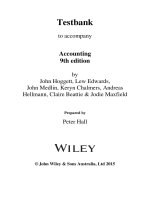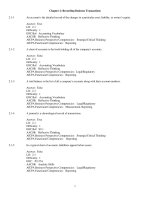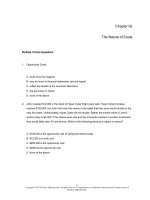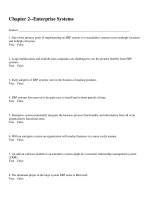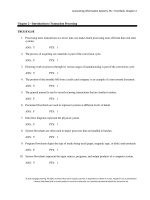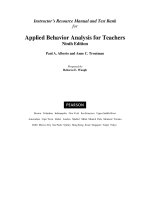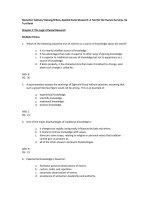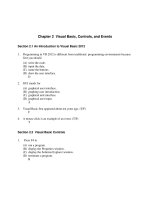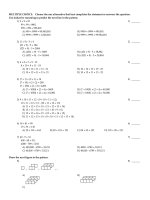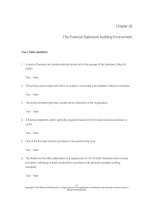Contemporary nutrition 9th edition wardlaw test bank
Bạn đang xem bản rút gọn của tài liệu. Xem và tải ngay bản đầy đủ của tài liệu tại đây (219.2 KB, 33 trang )
Chapter 02 - Guidelines for Designing a Healthy Diet
Chapter 02
Guidelines for Designing a Healthy Diet
Fill in the Blank Questions
1. Alan has been hospitalized and you are concerned about his nutritional status. The five
ways you would attempt to assess his nutritional status would be to take anthropometric
measurements, determine economic status, and do a biochemical evaluation, clinical
examination, and _______________ analysis.
dietary or
diet
Bloom's Level: 1. Remember
Learning Outcome: 02.02 Outline the measurements used (ABCDEs) in nutrition assessment:
anthropometric, biochemical, clinical, dietary, and environmental status.
Section: 02.03 How Can Your Nutritional State Be Measured?
Topic: Healthy Diet Guidelines
2. The RDAs are designed to cover the needs of ______% of the population.
97 or
ninety-seven
Bloom's Level: 1. Remember
Learning Outcome: 02.04 Describe what the Recommended Dietary Allowances (RDAs) and
other dietary standards represent.
Section: 02.05 Specific Nutrient Standards and Recommendations
Topic: Healthy Diet Guidelines
2-1
Chapter 02 - Guidelines for Designing a Healthy Diet
3. The _______________ are the recommended nutrient intakes that meet the needs of
essentially all healthy people of similar age and gender.
RDAs or
Recommended Dietary Allowances or
Recommended Dietary Allowance or
RDA
Bloom's Level: 1. Remember
Learning Outcome: 02.04 Describe what the Recommended Dietary Allowances (RDAs) and
other dietary standards represent.
Section: 02.05 Specific Nutrient Standards and Recommendations
Topic: Healthy Diet Guidelines
4. When there is insufficient research to determine the RDA for a nutrient, the ______, based
on estimates of intakes that appear to maintain a defined nutritional state in a specific life
stage, is the nutrient standard.
AI or
AIs or
Adequate Intake or
Adequate Intakes
Bloom's Level: 1. Remember
Learning Outcome: 02.04 Describe what the Recommended Dietary Allowances (RDAs) and
other dietary standards represent.
Section: 02.05 Specific Nutrient Standards and Recommendations
Topic: Healthy Diet Guidelines
2-2
Chapter 02 - Guidelines for Designing a Healthy Diet
5. A _______________ is generally a fake medicine used to disguise the treatments of
participants in an experiment.
placebo
Bloom's Level: 1. Remember
Learning Outcome: 02.03 Understand the basis of the scientific method as it is used in
developing hypotheses and theories in the field of nutrition, including the determination of
nutrient needs.
Section: 02.04 Using the Scientific Method to Determine Nutrient Needs
Topic: Healthy Diet Guidelines
6. According to the 2010 Dietary Guidelines, adults should _______________ intake of fatfree or low-fat milk and milk products.
increase
Bloom's Level: 1. Remember
Learning Outcome: 02.05 List the purpose and key recommendations of the Dietary
Guidelines and the 2008 Physical Activity Guidelines for Americans.
Section: 2.06 Recommendations for Healthy Living
Topic: Healthy Diet Guidelines
7. According to MyPlate, eggs belong in the _______________ group.
Protein Foods or
Protein or
Proteins
Bloom's Level: 2. Understand
Learning Outcome: 02.06 Exemplify a meal that conforms to MyPlate recommendations.
Section: 2.06 Recommendations for Healthy Living
Topic: Healthy Diet Guidelines
2-3
Chapter 02 - Guidelines for Designing a Healthy Diet
8. (p. 62) When using MyPlate to choose fruits and vegetables, one should include a vitamin
C source such as citrus fruit and a dark green vegetable each day, as a source of
_______________.
vitamin A
Bloom's Level: 1. Remember
Learning Outcome: 02.06 Exemplify a meal that conforms to MyPlate recommendations.
Section: 2.06 Recommendations for Healthy Living
Topic: Healthy Diet Guidelines
9. The amount of a particular nutrient in a serving of food compared to its kilocalorie content
is called its _______________.
nutrient density
Bloom's Level: 1. Remember
Learning Outcome: 02.01 Develop a healthy eating plan.
Section: 02.01 A Food Philosophy That Works
Topic: Healthy Diet Guidelines
10. (p. 55) Calories from solid fats and/or added sugars are also called _______________
calories.
empty
Bloom's Level: 1. Remember
Learning Outcome: 02.01 Develop a healthy eating plan.
Section: 2.06 Recommendations for Healthy Living
Topic: Healthy Diet Guidelines
2-4
Chapter 02 - Guidelines for Designing a Healthy Diet
11. (p. 51) The 2010 Dietary Guidelines recommend consuming less than 10% of calories
from ____________ fatty acids.
saturated or
trans
Bloom's Level: 1. Remember
Learning Outcome: 02.05 List the purpose and key recommendations of the Dietary
Guidelines and the 2008 Physical Activity Guidelines for Americans.
Section: 2.06 Recommendations for Healthy Living
Topic: Healthy Diet Guidelines
12. Which government agency is responsible for most U.S. food labeling?
FDA or
Food and Drug Administration or
Food & Drug Administration
Bloom's Level: 1. Remember
Learning Outcome: 02.07 Describe the components of the Nutrition Facts panel and the
various health claims and label descriptors that are allowed.
Section: 02.07 Food Labels and Diet Planning
Topic: Healthy Diet Guidelines
2-5
Chapter 02 - Guidelines for Designing a Healthy Diet
Multiple Choice Questions
13. Which of the following is true about the way we should eat to achieve good nutritional
status?
A. Eat fruits and vegetables because we can get all the nutrients we need from these.
B. Do the best we can but take supplements to fill in the deficient areas.
C. Eat a wide variety of foods because no single natural food meets all human nutrient needs.
D. Eat only plant products because animal products are bad and generally filled with
hormones for animal growth.
Bloom's Level: 2. Understand
Bloom's Level: 3. Apply
Learning Outcome: 02.01 Develop a healthy eating plan.
Section: 02.01 A Food Philosophy That Works
Topic: Healthy Diet Guidelines
14. Which meal contains foods from all food groups represented in MyPlate?
A. Chef's salad containing ham, lettuce, an egg, Thousand Island dressing, and croutons;
bagel; apple; and soft drink
B. Steak, baked potato with margarine, broccoli, salad with oil and vinegar dressing, milk
C. Refried beans, onions, tomatoes, and cheddar cheese wrapped in a tortilla; orange; and
water
D. Pasta, marinara (tomato) sauce with clams, house salad with vegetables, Italian bread with
butter, and wine
Bloom's Level: 3. Apply
Learning Outcome: 02.06 Exemplify a meal that conforms to MyPlate recommendations.
Section: 2.06 Recommendations for Healthy Living
Topic: Healthy Diet Guidelines
2-6
Chapter 02 - Guidelines for Designing a Healthy Diet
15. Ann Miles, a triathlete, wants to eat a health-promoting diet and achieve dietary
adequacy. Which principles should she follow to achieve dietary balance?
A. Eat only unrefined plant products.
B. Consume a variety of foods from MyPlate's five major food groups every day.
C. Eat only "good" foods such as fruits and vegetables and avoid the "bad" foods such as
steak and ice cream.
D. Plan to eat something relatively low in fat and sodium for dinner if she had a high fat and
high sodium breakfast.
Bloom's Level: 3. Apply
Learning Outcome: 02.01 Develop a healthy eating plan.
Section: 02.01 A Food Philosophy That Works
Topic: Healthy Diet Guidelines
16. Which statement best describes the healthful diet principle of moderation?
A. Choose a number of different foods within any given food group rather than the "same old
thing."
B. Consume a variety of foods from MyPlate's five major food groups every day.
C. Pay attention to portion size and plan your entire day's diet so that you don't overconsume
nutrient sources.
D. Consume foods that have the most nutrition for their kilocalories.
Bloom's Level: 1. Remember
Learning Outcome: 02.01 Develop a healthy eating plan.
Section: 02.01 A Food Philosophy That Works
Topic: Healthy Diet Guidelines
2-7
Chapter 02 - Guidelines for Designing a Healthy Diet
17. Which statement best describes nutrient density?
A. Choose a number of different foods within any given food group rather than the "same old
thing."
B. Consume a variety of foods from MyPyramid's five major food groups every day.
C. Plan your entire day's diet so that you don't overconsume nutrient sources.
D. Consume foods that have the most nutrition for their kilocalories.
Bloom's Level: 1. Remember
Learning Outcome: 02.01 Develop a healthy eating plan.
Section: 02.01 A Food Philosophy That Works
Topic: Healthy Diet Guidelines
18. Which statement best describes the healthful diet principle of balance?
A. Choose a number of different foods within any given food group rather than the "same old
thing."
B. Consume a variety of foods from each of MyPlate's five major food groups every day.
C. Plan your entire day's diet so that you don't overconsume nutrient sources.
D. Consume foods that have the most nutrition for their kilocalories.
Bloom's Level: 1. Remember
Learning Outcome: 02.01 Develop a healthy eating plan.
Section: 02.01 A Food Philosophy That Works
Topic: Healthy Diet Guidelines
19. Measurements of height, weight, body circumferences, and body fat are called
A. sonography.
B. electrocardiography.
C. echocardiography.
D. anthropometry.
Bloom's Level: 1. Remember
Learning Outcome: 02.02 Outline the measurements used (ABCDEs) in nutrition assessment:
anthropometric, biochemical, clinical, dietary, and environmental status.
Section: 02.03 How Can Your Nutritional State Be Measured?
Topic: Healthy Diet Guidelines
2-8
Chapter 02 - Guidelines for Designing a Healthy Diet
20. Which of the following measures does not assess nutritional status?
A. Dietary analysis
B. Biochemical evaluation
C. Clinical evaluation
D. Psychoanalysis
Bloom's Level: 2. Understand
Learning Outcome: 02.02 Outline the measurements used (ABCDEs) in nutrition assessment:
anthropometric, biochemical, clinical, dietary, and environmental status.
Section: 02.03 How Can Your Nutritional State Be Measured?
Topic: Healthy Diet Guidelines
21. The acronym RDA stands for
A. Recommended Dietary Allowance.
B. Recommended Daily Allowance.
C. Required Dietary Allowance.
D. Required Daily Allowance.
Bloom's Level: 1. Remember
Learning Outcome: 02.04 Describe what the Recommended Dietary Allowances (RDAs) and
other dietary standards represent.
Section: 02.05 Specific Nutrient Standards and Recommendations
Topic: Healthy Diet Guidelines
22. Which term describes failing health that results from a long-standing dietary intake that
does not meet nutritional needs?
A. Desirable nutrition
B. Balanced nutrition
C. Undernutrition
D. Inferior nutrition
Bloom's Level: 1. Remember
Learning Outcome: 02.01 Develop a healthy eating plan.
Section: 02.02 States of Nutritional Health
Topic: Healthy Diet Guidelines
2-9
Chapter 02 - Guidelines for Designing a Healthy Diet
23. The RDAs are considered to be adequate to meet the known nutritional needs of
A. all persons except the very young and very old.
B. all persons except pregnant and lactating women.
C. nearly all healthy persons.
D. all persons diseased and healthy.
Bloom's Level: 1. Remember
Learning Outcome: 02.04 Describe what the Recommended Dietary Allowances (RDAs) and
other dietary standards represent.
Section: 02.05 Specific Nutrient Standards and Recommendations
Topic: Healthy Diet Guidelines
24. The RDAs for nutrients generally are
A. the minimum amounts the average adult male requires.
B. more than twice the requirements.
C. designed to prevent deficiency disease in half the population.
D. designed to be adequate for almost all healthy people.
Bloom's Level: 2. Understand
Learning Outcome: 02.04 Describe what the Recommended Dietary Allowances (RDAs) and
other dietary standards represent.
Section: 02.05 Specific Nutrient Standards and Recommendations
Topic: Healthy Diet Guidelines
25. If an individual's intake of a nutrient is less than the RDA, the individual
A. is likely to be deficient in that nutrient.
B. is suffering from a deficiency of that nutrient.
C. has a 97.5% probability of being deficient in that nutrient.
D. may or may not be deficient.
Bloom's Level: 2. Understand
Learning Outcome: 02.04 Describe what the Recommended Dietary Allowances (RDAs) and
other dietary standards represent.
Section: 02.05 Specific Nutrient Standards and Recommendations
Topic: Healthy Diet Guidelines
2-10
Chapter 02 - Guidelines for Designing a Healthy Diet
26. Tina is consuming 15 mg of iron per day. Her RDA is 18 mg. She has no condition
warranting a greater-than-normal need for iron. Which of the following statements is true
about her consumption of this nutrient?
A. She is likely to be deficient in iron.
B. She will need to consume significantly more iron, above the RDA, to make up for her
intake.
C. Only if her intake is consistently less than 70% of the RDA would she be at great risk of
nutritional deficiency.
D. She couldn't possibly be getting enough iron for her needs.
Bloom's Level: 5. Evaluate
Learning Outcome: 02.04 Describe what the Recommended Dietary Allowances (RDAs) and
other dietary standards represent.
Section: 02.05 Specific Nutrient Standards and Recommendations
Topic: Healthy Diet Guidelines
27. Adequate Intakes (AI)
A. are established for nutrients for which there is not enough information to set RDAs.
B. are established for carbohydrate, total fat, and dietary fiber.
C. represent minimum nutrient needs.
D. are established for all vitamins and minerals.
Bloom's Level: 1. Remember
Learning Outcome: 02.04 Describe what the Recommended Dietary Allowances (RDAs) and
other dietary standards represent.
Section: 02.05 Specific Nutrient Standards and Recommendations
Topic: Healthy Diet Guidelines
2-11
Chapter 02 - Guidelines for Designing a Healthy Diet
28. You pick up a box of Cheerios cereal in the supermarket. The Nutrition Facts panel tells
you that a 1-cup serving provides 25 percent of the ______ for iron.
A. RDA
B. Daily Value
C. Minimum Requirement
D. ESADDI
Bloom's Level: 3. Apply
Learning Outcome: 02.07 Describe the components of the Nutrition Facts panel and the
various health claims and label descriptors that are allowed.
Section: 02.07 Food Labels and Diet Planning
Topic: Healthy Diet Guidelines
29. One serving of Raisin Bran cereal contains 50 percent of the 18 mg Daily Value for iron.
How much iron will one serving of your cereal provide?
A. 5 mg
B. 9 mg
C. 15 mg
D. 36 mg
Bloom's Level: 3. Apply
Learning Outcome: 02.07 Describe the components of the Nutrition Facts panel and the
various health claims and label descriptors that are allowed.
Section: 02.07 Food Labels and Diet Planning
Topic: Healthy Diet Guidelines
2-12
Chapter 02 - Guidelines for Designing a Healthy Diet
30. A food label states that a serving of a particular product contains 13 grams of total fat and
20 percent of the Daily Value for fat. This means that
A. when you eat a serving of this product, you will be getting 20 percent of the RDA for fat.
B. when you eat a serving of this product you will be getting 20 percent of the Daily
Reference Value for total fat based on a 2,000-kcalorie diet.
C. you should eat more of the product to get the amount of fat you need that would equal 100
percent of the Daily Reference Value.
D. you should eat more of the product to get the amount of fat you need that would equal 100
percent of the RDA.
Bloom's Level: 2. Understand
Learning Outcome: 02.07 Describe the components of the Nutrition Facts panel and the
various health claims and label descriptors that are allowed.
Section: 02.07 Food Labels and Diet Planning
Topic: Healthy Diet Guidelines
31. The term "Daily Values" on a food label refers to
A. a generic standard set at or close to the highest RDA value or related nutrient standard.
B. RDAs.
C. minimum requirements.
D. AIs.
Bloom's Level: 2. Understand
Learning Outcome: 02.07 Describe the components of the Nutrition Facts panel and the
various health claims and label descriptors that are allowed.
Section: 02.07 Food Labels and Diet Planning
Topic: Healthy Diet Guidelines
2-13
Chapter 02 - Guidelines for Designing a Healthy Diet
32. The label on a package of Kool Aid indicates that it contains vitamin C. The amount
listed is a percentage of the
A. Daily Value.
B. RDA.
C. minimum requirement.
D. AI.
Bloom's Level: 2. Understand
Learning Outcome: 02.07 Describe the components of the Nutrition Facts panel and the
various health claims and label descriptors that are allowed.
Section: 02.07 Food Labels and Diet Planning
Topic: Healthy Diet Guidelines
33. According to MyPlate, consumption of foods from the Grains group should include
A. an equal amount of whole grain and refined grain products.
B. at least half of the grain servings as whole grain cereals, breads, crackers, rice, or pasta
every day.
C. only whole grain products.
D. a serving of grain products at each meal.
Bloom's Level: 1. Remember
Learning Outcome: 02.06 Exemplify a meal that conforms to MyPlate recommendations.
Section: 2.06 Recommendations for Healthy Living
Topic: Healthy Diet Guidelines
2-14
Chapter 02 - Guidelines for Designing a Healthy Diet
34. According to MyPlate, an adult age 18 or older should consume how many cups of milk
or milk equivalent per day on a 2,000-calorie diet?
A. 1
B. 2
C. 3
D. 4
Bloom's Level: 1. Remember
Learning Outcome: 02.06 Exemplify a meal that conforms to MyPlate recommendations.
Section: 2.06 Recommendations for Healthy Living
Topic: Healthy Diet Guidelines
35. EER refers to
A. a set of nutrient recommendations that includes RDAs, AIs, and ULs.
B. estimated calorie needs for the average person of a specific height, weight, age, gender,
and physical activity pattern.
C. a person's actual calorie needs, as measured by calorimetry.
D. the level of dietary intake of a nutrient that is likely to meet the needs of nearly all healthy
individuals in a particular life stage and gender group.
Bloom's Level: 1. Remember
Learning Outcome: 02.04 Describe what the Recommended Dietary Allowances (RDAs) and
other dietary standards represent.
Section: 02.05 Specific Nutrient Standards and Recommendations
Topic: Healthy Diet Guidelines
2-15
Chapter 02 - Guidelines for Designing a Healthy Diet
36. Which of the following is not a true statement about the MyPlate Fruit group?
A. Eat 2 cups every day for every 2000 kcal.
B. Eat a variety of fruit.
C. Include plenty of fruit juices for your fruit servings.
D. Choose fresh, frozen, canned, or dried fruit.
Bloom's Level: 2. Understand
Learning Outcome: 02.06 Exemplify a meal that conforms to MyPlate recommendations.
Section: 2.06 Recommendations for Healthy Living
Topic: Healthy Diet Guidelines
37. (p. 57) According to MyPlate, how much do you need from the Protein Foods group
when consuming a 2,000-calorie diet?
A. 2 to 3 ounce-equivalents every day
B. 4 ounce-equivalents every day
C. 5 1/2 ounce-equivalents every day
D. 10 ounce-equivalents every day
Bloom's Level: 1. Remember
Learning Outcome: 02.06 Exemplify a meal that conforms to MyPlate recommendations.
Section: 2.06 Recommendations for Healthy Living
Topic: Healthy Diet Guidelines
38. Which of the following is true about the use of MyPlate?
A. The guide applies to infants.
B. Milk and meat are essential to good nutrition.
C. Variety is the key to the plan.
D. The guide does not permit use of fats, oils, and sweets.
Bloom's Level: 2. Understand
Learning Outcome: 02.06 Exemplify a meal that conforms to MyPlate recommendations.
Section: 2.06 Recommendations for Healthy Living
Topic: Healthy Diet Guidelines
2-16
Chapter 02 - Guidelines for Designing a Healthy Diet
39. Margaret, an elderly woman, needs to limit her kilocalorie intake without sacrificing
needed nutrients. Keeping in mind MyPlate, which of the following could she do?
A. Eliminate carbohydrate.
B. Carefully select foods rich in nutrients but low in kilocalories.
C. Count kilocalories and not worry about the food groups.
D. Eliminate dairy foods.
Bloom's Level: 3. Apply
Learning Outcome: 02.06 Exemplify a meal that conforms to MyPlate recommendations.
Section: 2.06 Recommendations for Healthy Living
Topic: Healthy Diet Guidelines
40. Which of the following is not a wise application of MyPlate?
A. Using low-fat and nonfat choices for milk and cheese
B. Including several servings of vegetable proteins per week
C. Using whole grain breads and cereals
D. Eliminating foods from the Fruits group to lose weight
Bloom's Level: 3. Apply
Learning Outcome: 02.06 Exemplify a meal that conforms to MyPlate recommendations.
Section: 2.06 Recommendations for Healthy Living
Topic: Healthy Diet Guidelines
41. Nutrient density can be defined as the amount of
A. a particular nutrient in a serving of food divided by the number of kilocalories in that
serving.
B. a particular nutrient in a serving of food divided by the number of grams of protein.
C. kilocalories in a food divided by the amount of kilocalories needed in a day.
D. a nutrient in a serving of food divided by the amount of the nutrient needed for that day.
Bloom's Level: 1. Remember
Learning Outcome: 02.01 Develop a healthy eating plan.
Section: 02.01 A Food Philosophy That Works
Topic: Healthy Diet Guidelines
2-17
Chapter 02 - Guidelines for Designing a Healthy Diet
42. One cup of apple juice has 111 kilocalories and 1.4 mg of vitamin C. The same serving
size of orange juice has 112 kilocalories and 124 mg of vitamin C. Which of the following is
true regarding their nutrient density?
A. Apple juice is more nutrient dense for vitamin C than orange juice.
B. To get adequate vitamin C while watching kilocalorie intake, it would be better to
consume apple juice than orange juice.
C. Apple juice provides more vitamin C per kilocalorie than orange juice.
D. Orange juice is more nutrient dense for vitamin C than apple juice.
Bloom's Level: 5. Evaluate
Learning Outcome: 02.01 Develop a healthy eating plan.
Section: 02.01 A Food Philosophy That Works
Topic: Healthy Diet Guidelines
43. The acronym DRI stands for
A. Dietary Required Intake.
B. Dietary Reference Intake.
C. Daily Required Intake.
D. Daily Reference Intake.
Bloom's Level: 1. Remember
Learning Outcome: 02.04 Describe what the Recommended Dietary Allowances (RDAs) and
other dietary standards represent.
Section: 02.05 Specific Nutrient Standards and Recommendations
Topic: Healthy Diet Guidelines
2-18
Chapter 02 - Guidelines for Designing a Healthy Diet
44. The 2010 Dietary Guidelines for Americans recommend which of the following?
A. Consume fewer foods with sodium (salt), saturated fats, trans fats, cholesterol, added
sugars, and refined grains.
B. Consume two alcoholic beverages per day.
C. Eliminate oils and solid fats from the diet.
D. Decrease vegetable and fruit intake.
Bloom's Level: 2. Understand
Learning Outcome: 02.05 List the purpose and key recommendations of the Dietary
Guidelines and the 2008 Physical Activity Guidelines for Americans.
Section: 2.06 Recommendations for Healthy Living
Topic: Healthy Diet Guidelines
45. The most important changes in the 2010 Dietary Guidelines include powerful emphases
on
A. reduction of both total calories and physical activity.
B. reduction of total calories, sugar-sweetened beverages, saturated fat, and sodium.
C. increase in animal protein and refined grains.
D. increase in all types of dairy products.
Bloom's Level: 2. Understand
Learning Outcome: 02.05 List the purpose and key recommendations of the Dietary
Guidelines and the 2008 Physical Activity Guidelines for Americans.
Section: 2.06 Recommendations for Healthy Living
Topic: Healthy Diet Guidelines
2-19
Chapter 02 - Guidelines for Designing a Healthy Diet
46. Which of the following statements is consistent with the 2010 Dietary Guidelines for
Americans?
A. Choose a diet very low in fat and cholesterol.
B. Balance the calories you eat with physical activity.
C. Choose a diet with plenty of animal products including milk and meats.
D. Eat an abundance of saturated fats.
Bloom's Level: 2. Understand
Learning Outcome: 02.05 List the purpose and key recommendations of the Dietary
Guidelines and the 2008 Physical Activity Guidelines for Americans.
Section: 2.06 Recommendations for Healthy Living
Topic: Healthy Diet Guidelines
47. Which of the following is not a limitation of nutritional assessments?
A. A long time may elapse between the initial development of poor nutritional health and the
first clinical evidence of a problem.
B. Clinical signs and symptoms of nutritional deficiencies often are not very specific.
C. Often it is not possible to separate the best nutritional state from one that is slightly
jeopardized.
D. Most nutrition assessments are time-consuming, costly, and do not provide valuable
information.
Bloom's Level: 2. Understand
Learning Outcome: 02.02 Outline the measurements used (ABCDEs) in nutrition assessment:
anthropometric, biochemical, clinical, dietary, and environmental status.
Section: 02.03 How Can Your Nutritional State Be Measured?
Topic: Healthy Diet Guidelines
2-20
Chapter 02 - Guidelines for Designing a Healthy Diet
48. Jeff, a world-class triathlete, visits a dietitian to obtain sports nutrition advice. During his
visit, Jeff is asked to recall what he ate for the past 24 hours. Which part of a nutritional
assessment is this?
A. Biochemical evaluation
B. Dietary assessment
C. Clinical examination
D. Menu planning
Bloom's Level: 2. Understand
Learning Outcome: 02.02 Outline the measurements used (ABCDEs) in nutrition assessment:
anthropometric, biochemical, clinical, dietary, and environmental status.
Section: 02.03 How Can Your Nutritional State Be Measured?
Topic: Healthy Diet Guidelines
49. Missy visits a doctor because she feels tired most of the time, is easily distracted, and
feels chilled. As part of her examination, Missy has blood drawn to be tested for
concentrations of nutrients and their by-products. This part of the examination is the
A. anthropometric assessment.
B. physical examination.
C. biochemical evaluation.
D. clinical examination.
Bloom's Level: 2. Understand
Learning Outcome: 02.02 Outline the measurements used (ABCDEs) in nutrition assessment:
anthropometric, biochemical, clinical, dietary, and environmental status.
Section: 02.03 How Can Your Nutritional State Be Measured?
Topic: Healthy Diet Guidelines
2-21
Chapter 02 - Guidelines for Designing a Healthy Diet
50. Mrs. Mitchell was hospitalized after being found unconscious in her home. A dietitian
conducted a nutritional assessment noting the general appearance of Mrs. Mitchell's skin,
eyes, and tongue. Which part of the assessment is this?
A. Medical history
B. Diet history
C. Biochemical evaluation
D. Clinical examination
Bloom's Level: 2. Understand
Learning Outcome: 02.02 Outline the measurements used (ABCDEs) in nutrition assessment:
anthropometric, biochemical, clinical, dietary, and environmental status.
Section: 02.03 How Can Your Nutritional State Be Measured?
Topic: Healthy Diet Guidelines
51. Kate consumes 1,900 kcalories each day. She requires 1,750 kcalories to meet daily
energy needs. Over time, Kate's kcalorie consumption could lead to
A. undernutrition.
B. unbalanced nutrition.
C. balanced nutrition.
D. overnutrition.
Bloom's Level: 2. Understand
Learning Outcome: 02.01 Develop a healthy eating plan.
Section: 02.02 States of Nutritional Health
Topic: Healthy Diet Guidelines
2-22
Chapter 02 - Guidelines for Designing a Healthy Diet
52. Which government agency is responsible for regulating most U.S. food labeling?
A. Food and Drug Administration
B. U.S. Department of Agriculture
C. Bureau of Alcohol, Tobacco, and Firearms
D. Center for Science in the Public Interest
Bloom's Level: 1. Remember
Learning Outcome: 02.07 Describe the components of the Nutrition Facts panel and the
various health claims and label descriptors that are allowed.
Section: 02.07 Food Labels and Diet Planning
Topic: Healthy Diet Guidelines
53. When looking at the ingredient label of a bottled spaghetti sauce, you see that olive oil is
the second ingredient. This means that olive oil is
A. the second ingredient by alphabetical listing.
B. just one of the ingredients present in the sauce.
C. the second most abundant ingredient by weight.
D. the second most abundant ingredient by volume.
Bloom's Level: 2. Understand
Learning Outcome: 02.07 Describe the components of the Nutrition Facts panel and the
various health claims and label descriptors that are allowed.
Section: 02.07 Food Labels and Diet Planning
Topic: Healthy Diet Guidelines
2-23
Chapter 02 - Guidelines for Designing a Healthy Diet
54. A nutrition label must be present on the product if
A. a claim is made about the health benefits of a specific nutrient.
B. the food is a packaged item.
C. the food is prepared using a specific standardized recipe, such as catsup.
D. the food is sold in the supermarket.
Bloom's Level: 2. Understand
Learning Outcome: 02.07 Describe the components of the Nutrition Facts panel and the
various health claims and label descriptors that are allowed.
Section: 02.07 Food Labels and Diet Planning
Topic: Healthy Diet Guidelines
55. Which of the following is not required on a nutrition label?
A. The amount of all vitamins and minerals for which there is an RDA
B. The serving size
C. Total kcalories from fat per serving
D. Total fat, saturated fat, cholesterol, sodium, protein, and total carbohydrate in sugars and
dietary fiber
Bloom's Level: 1. Remember
Learning Outcome: 02.07 Describe the components of the Nutrition Facts panel and the
various health claims and label descriptors that are allowed.
Section: 02.07 Food Labels and Diet Planning
Topic: Healthy Diet Guidelines
2-24
Chapter 02 - Guidelines for Designing a Healthy Diet
56. According to the 2010 Dietary Guidelines, the food and nutrients to increase are
A. milk, meat, and beans.
B. fruits, vegetables, low-fat milk, and whole grains.
C. grains, beans, and solid fats.
D. fruit juice, beans, and meat.
Bloom's Level: 2. Understand
Learning Outcome: 02.05 List the purpose and key recommendations of the Dietary
Guidelines and the 2008 Physical Activity Guidelines for Americans.
Section: 2.06 Recommendations for Healthy Living
Topic: Healthy Diet Guidelines
57. The number of servings to consume from each MyPlate food group depends on a person's
A.
B.
C.
D.
height, weight, and waist circumference.
taste preferences.
age, gender, height, and weight.
frame size.
Bloom's Level: 2. Understand
Learning Outcome: 02.06 Exemplify a meal that conforms to MyPlate recommendations.
Section: 2.06 Recommendations for Healthy Living
Topic: Healthy Diet Guidelines
2-25
